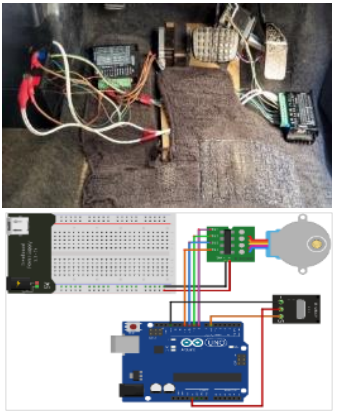Infrared sensor-based remote controlled driving system for people with lower body disability and leg impairment
Main Article Content
Abstract
The ever-increasing demand for independent mobility has escalated vehicle production across the globe. However, very less focus is given to drivers who are physically impaired or have a driving disability. Thus, the primary purpose of this research is to design a low-cost infrared sensor-based remote-operated driving system for people with lower body disabilities and leg impairment. The presented design is based on an Arduino UNO microcontroller that is programmed and coupled to an infrared sensor to press and release the brake and acceleration pedals, which can be hand-controlled by the disabled driver. Two TB6600 microstepping drivers and NEMA-23 stepper motors have been externally powered using a Volta 12V lead-acid maintenance-free battery at 2.5 amperes with a peak current of 2.7A, and 200 steps/rev. for maximum output torque. An LED and alarm have been placed on the dashboard for an emergency alert or system failure. Additionally, brake and acceleration pedals have been tied to a monofilament cord, which further connects the motor shafts to assist pedalling operation and allows the driver to control the brake and acceleration pedals through an IR remote. The findings comprise two models: theoretical and actual. Results show that theoretical braking time is around 0.7s while actual braking time is found as 0.6s, which shows a good agreement.
Downloads
Article Details

This work is licensed under a Creative Commons Attribution-NonCommercial 4.0 International License.
References
[2] T. Doi et al., "Impact of social frailty on the association between driving status and disability in older adults," Archives of Gerontology and Geriatrics, vol. 99, no. November 2021, p. 104597, 2022, doi: 10.1016/j.archger.2021.104597.
https://doi.org/10.1016/j.archger.2021.104597
[3] WorldBank, "Population of Pakistan as of 2020," data.worldbank.org/, 2020. https://data.worldbank.org/indicator/SP.POP.TOTL?locations=PK&most_recent_value_desc=true.
[4] Pakistan Bureau of Statistics, "Vehicle Ownership in Pakistan," pbs.gov.pk, 2020. http://www.pbs.gov.pk/content/pakistan-statistical-year-book-2018-provisional.
[5] W. H. Syed, A. Yasar, D. Janssens, and G. Wets, "Analyzing the real time factors: Which causing the traffic congestions and proposing the solution for Pakistani city," Procedia Computer Science, vol. 32, pp. 413-420, 2014.
https://doi.org/10.1016/j.procs.2014.05.442
[6] A. Raza et al., "Evaluation of a Sustainable Urban Transportation System in Terms of Traffic Congestion - A Case Study in Taxila , Pakistan," Sustainability, vol. 14, pp. 1-25, 2022.
https://doi.org/10.3390/su141912325
[7] H. Farman, Z. Khan, B. Jan, W. Boulila, S. Habib, and A. Koubaa, "Smart Transportation in Developing Countries: An Internet-of-Things-Based Conceptual Framework for Traffic Control," Wireless Communications and Mobile Computing, vol. 2022, 2022.
https://doi.org/10.1155/2022/8219377
[8] Pakistan Safety Council, "Speed Limits in Pakistan," psc.org.pk, 2020. https://www.psc.org.pk/speed-limits/.
[9] G. Lavanya, M. Deva Priya, A. Balamurugan, and A. Christy Jeba Malar, "An adaptive throttle and brake control system for automatic cruise control in disability support vehicle," ACM International Conference Proceeding Series, no. 2014, 2019.
https://doi.org/10.1145/3368756.3369045
[10] G. Goggin, "Disability, connected cars, and communication," International Journal of Communication, vol. 13, pp. 2748-2773, 2019.
[11] A. Al-Fuqaha, J. Oh, and V. Kwigizile, "Vehicle-to-Device ( V2D ) Communications : Readiness of the Technology and Potential Applications for People with Disability," Michigan, 2018.
[12] S. Ravikiran and C. Byrappa, "Design of Multi-Utility Personal Mobility Vehicle for People with Disability," Journal of Recent Trends in Mechanics, vol. 3, no. 1, pp. 1-9, 2018, [Online]. Available: https://core.ac.uk/download/pdf/230497575.pdf.
[13] Hudson, "HDS Specialty Vehicles," hdsmn.com, 2019. http://hdsmn.com/index.html.
[14] SV-Options, "Specialized Vehicle Options (SVO) Ltd.," svoptions.co.uk, 2020. https://www.svoptions.co.uk.
[15] SDL, "Steering Developments Limited," steeringdevelopments.co.uk, 2020. https://www.steeringdevelopments.co.uk/products/push-pull-hand-controls.
[16] Brig, "Brig-Ayd Controls," brig-aydcontrols.co.uk, 2020. https://www.brig-aydcontrols.co.uk.
[17] I. Fallon and D. O'Neill, "The world's first automobile fatality," Accident Analysis & Prevention, vol. 37, no. 4, pp. 601-603, 2005.
https://doi.org/10.1016/j.aap.2005.02.002
[18] M. T. Emirler, H. Wang, and B. A. Güvenç, "Socially acceptable collision avoidance system for vulnerable road users," IFAC-PapersOnLine, vol. 49, no. 3, pp. 436-441, 2016.
https://doi.org/10.1016/j.ifacol.2016.07.073
[19] R. Isermann, R. Mannale, and K. Schmitt, "Collision-avoidance systems PRORETA: Situation analysis and intervention control," Control Engineering Practice, vol. 20, no. 11, pp. 1236-1246, 2012.
https://doi.org/10.1016/j.conengprac.2012.06.003
[20] M. Schiebahn, S. Drogies, M. Schölzke, U. Bonné, A. Heitmann, and P. Heitkämper, "Improved active safety through collision mitigation system based on single forward looking radar sensor," IFAC Proceedings Volumes, vol. 43, no. 7, pp. 483-488, 2010.
https://doi.org/10.3182/20100712-3-DE-2013.00023
[21] F. Meng and C. Spence, "Tactile warning signals for in-vehicle systems," Accident analysis & prevention, vol. 75, pp. 333-346, 2015.
https://doi.org/10.1016/j.aap.2014.12.013
[22] O. D. Altan, "Vehicle architecture for field testing forward collision warning and adaptive cruise control," IFAC Proceedings Volumes, vol. 35, no. 2, pp. 203-208, 2002.
https://doi.org/10.1016/S1474-6670(17)33942-3
[23] J. Assaad, A. Menhaj, J. M. Rouvaen, C. Bruneel, and P. Deloof, "Signal processing study for an FM CW collision avoidance radar system," Signal processing, vol. 61, no. 1, pp. 83-88, 1997.
https://doi.org/10.1016/S0165-1684(97)00093-5
[24] Pama, "Production & Sale Data of Vehicles," pama.org.pk, 2019. https://www.pama.org.pk/statistical-information/sales-production/monthlysales-production.
[25] H. Tomizawa and T. E. Fischer, "Friction and Wear of Silicon Nitride at 150° C to 800° C," ASLE transactions, vol. 29, no. 4, pp. 481-488, 1986.
https://doi.org/10.1080/05698198608981711
[26] A. A. Kordani, O. Rahmani, A. S. A. Nasiri, and S. M. Boroomandrad, "Effect of adverse weather conditions on vehicle braking distance of highways," Civil Engineering Journal, vol. 4, no. 1, pp. 46-57, 2018.
https://doi.org/10.28991/cej-030967

